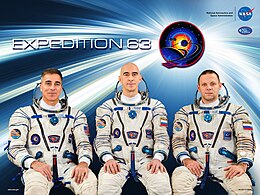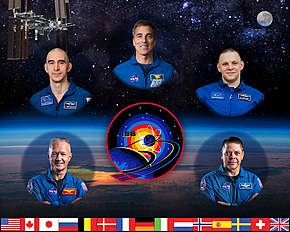
Robert Shane Kimbrough is a retired United States Army officer and NASA astronaut. He was part of the first group of candidates selected for NASA astronaut training following the Space Shuttle Columbia disaster. Kimbrough is a veteran of three spaceflights, the first being a Space Shuttle flight, and the second being a six-month mission to the ISS on board a Russian Soyuz craft. He was the commander of the International Space Station for Expedition 50, and returned to Earth in April 2017. He is married to the former Robbie Lynn Nickels.

STS-127 was a NASA Space Shuttle mission to the International Space Station (ISS). It was the twenty-third flight of Space ShuttleEndeavour. The primary purpose of the STS-127 mission was to deliver and install the final two components of the Japanese Experiment Module: the Exposed Facility, and the Exposed Section of the Experiment Logistics Module (ELM-ES). When Endeavour docked with the ISS on this mission in July 2009, it set a record for the most humans in space at the same time in the same vehicle, the first time thirteen people have been at the station at the same time. Together they represented all ISS program partners and tied the general record of thirteen people in space with the first such occurrence of 1995.

Christopher John "Chris" Cassidy is a retired NASA astronaut and United States Navy SEAL. Chris Cassidy achieved the rank of captain in the U.S. Navy. His first spaceflight was on a Space Shuttle mission in 2009. He was the Chief of the Astronaut Office at NASA from July 2015 until June 2017.

Robert Louis Behnken is an American engineer, a former NASA astronaut, and former Chief of the Astronaut Office.

Douglas Gerald Hurley is an American engineer, former Marine Corps pilot and former NASA astronaut. He piloted Space Shuttle missions STS-127 and STS-135, the final flight of the Space Shuttle program. He launched into space for the third time as commander of Crew Dragon Demo-2, the first crewed spaceflight from American soil since STS-135 and became, together with Bob Behnken, the first astronaut in history launching aboard a commercial orbital spacecraft. He was also the first Marine to fly the F/A-18 E/F Super Hornet. His call sign is "Chunky", and he was sometimes referred to by this name on the communication loops.
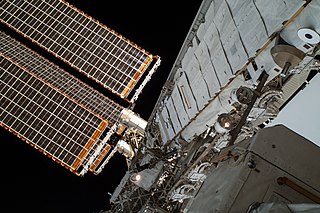
The Integrated Truss Structure (ITS) of the International Space Station (ISS) consists of a linear arranged sequence of connected trusses on which various unpressurized components are mounted such as logistics carriers, radiators, solar arrays, and other equipment. It supplies the ISS with a bus architecture. It is approximately 110 meters long and is made from aluminium and stainless steel.

The electrical system of the International Space Station is a critical resource for the International Space Station (ISS) because it allows the crew to live comfortably, to safely operate the station, and to perform scientific experiments. The ISS electrical system uses solar cells to directly convert sunlight to electricity. Large numbers of cells are assembled in arrays to produce high power levels. This method of harnessing solar power is called photovoltaics.
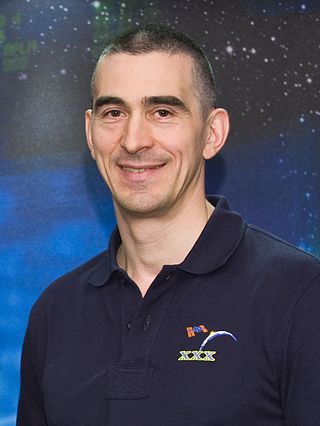
Anatoli Alekseyevich Ivanishin is a former Russian cosmonaut. His first visit to space was to the International Space Station on board the Soyuz TMA-22 spacecraft as an Expedition 29 / Expedition 30 crew member, launching in November 2011 and returning in April 2012. Ivanishin was the Commander of the International Space Station for Expedition 49.
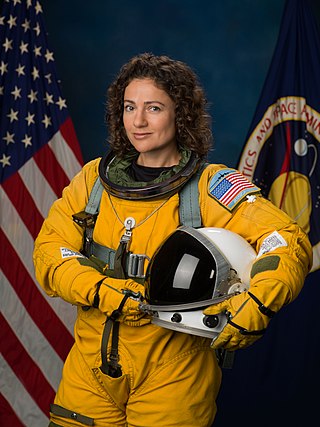
Jessica Ulrika Meir is an American NASA astronaut, marine biologist, and physiologist. She was previously an assistant professor of anesthesia at Harvard Medical School, Massachusetts General Hospital, Boston, following postdoctoral research in comparative physiology at the University of British Columbia. She has studied the diving physiology and behavior of emperor penguins in Antarctica, and the physiology of bar-headed geese, which are able to migrate over the Himalayas. In September 2002, Meir served as an aquanaut on the NASA Extreme Environment Mission Operations 4 crew. In 2013, she was selected by NASA to Astronaut Group 21. In 2016, Meir participated in ESA CAVES, a training course in which international astronauts train in a space-analogue cave environment. Meir launched on September 25, 2019, to the ISS onboard Soyuz MS-15, where she served as a flight Engineer during Expedition 61 and 62. On October 18, 2019, Meir and Christina Koch were the first women to participate in an all-female spacewalk.
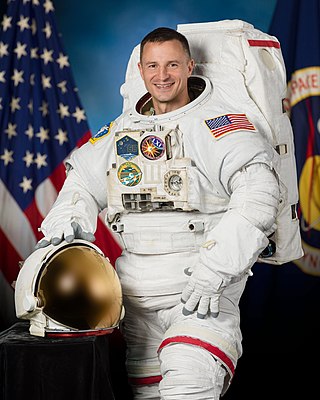
Andrew Richard "Drew" Morgan is a NASA astronaut from the class of 2013.

Dragon 2 is a class of partially reusable spacecraft developed, manufactured, and operated by American space company SpaceX, primarily for flights to the International Space Station (ISS). SpaceX also launches private missions, such as Inspiration4 and Axiom Space Missions. There are two variants of the Dragon spacecraft: Crew Dragon, a spacecraft capable of ferrying four crewmembers, and Cargo Dragon, a replacement for the original Dragon 1 used to carry freight to and from space. The spacecraft consists of a reusable space capsule and an expendable trunk module. The spacecraft launches atop a Falcon 9 Block 5 rocket and the capsule returns to Earth through splashdown.
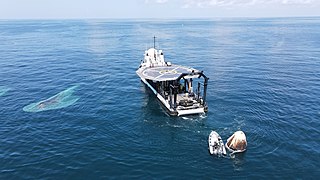
Crew Dragon Demo-2 was the first crewed test flight of the Crew Dragon spacecraft. The spacecraft, named Endeavour, launched on 30 May 2020 on a Falcon 9 rocket, and carried NASA astronauts Douglas Hurley and Robert Behnken to the International Space Station in the first crewed orbital spaceflight launched from the United States since the final Space Shuttle mission in 2011, and the first ever operated by a commercial provider. Demo-2 was also the first two-person orbital spaceflight launched from the United States since STS-4 in 1982. Demo-2 completed the validation of crewed spaceflight operations using SpaceX hardware and received human-rating certification for the spacecraft, including astronaut testing of Crew Dragon capabilities on orbit.

Kounotori 9 (こうのとり9号機), also known as HTV-9 was the 9th flight of the H-II Transfer Vehicle, a robotic cargo spacecraft to resupply the International Space Station (ISS). It was launched on 20 May 2020, at 17:31:00 UTC.

The Roll Out Solar Array (ROSA) and its larger version ISS Roll Out Solar Array (iROSA) are lightweight, flexible power sources for spacecraft designed and developed by Redwire.

Expedition 65 was the 65th long duration expedition to the International Space Station. The mission began on 17 April 2021, with the departure of Soyuz MS-17, and was initially commanded by NASA astronaut Shannon Walker serving as the third female ISS commander, who launched in November 2020 aboard SpaceX Crew-1 alongside NASA astronauts Michael S. Hopkins and Victor J. Glover, as well as JAXA astronaut Soichi Noguchi. They were joined by the crew of Soyuz MS-18, which is made up of Russian cosmonauts Oleg Novitsky and Pyotr Dubrov, as well as NASA astronaut Mark Vande Hei.

Expedition 64 was the 64th long-duration expedition to the International Space Station (ISS), that began on 21 October 2020 with the undocking and departure of Soyuz MS-16. The expedition started with the three crew members launched onboard Soyuz MS-17 and reached its full complement with the arrival of SpaceX Crew-1, the first operational flight of NASA's Commercial Crew Program (CCP). As Crew-1 consists of a crew of four instead of three like the Soyuz, Expedition 64 marks the beginning of operations for crews of seven on the ISS. In the final week of the mission, Soyuz MS-18 and its three person crew joined the mission. The expedition ended on 17 April 2021 with the departure of Soyuz MS-17.

Crew Dragon Endeavour is a Crew Dragon space capsule manufactured and operated by SpaceX and used by NASA's Commercial Crew Program. As of 2024 it has successfully completed four crewed missions to the International Space Station (ISS), and is currently conducting a fifth. It was first launched into orbit atop a Falcon 9 rocket on 30 May 2020 and successfully docked to the International Space Station (ISS) as part of the Crew Dragon Demo-2 mission. This was the first crewed flight test of a Dragon capsule, carrying Doug Hurley and Bob Behnken on first crewed orbital spaceflight from the United States since STS-135 in July 2011 and the first crewed orbital spaceflight by a private company. On 2 August 2020 it returned to Earth. The spacecraft was named by Hurley and Behnken after the Space ShuttleEndeavour, aboard which they first flew into space during the STS-127 and STS-123 missions, respectively. The name Endeavour is also shared by the command module of Apollo 15. The spacecraft's second mission, Crew-2, ended 8 November 2021 after having spent almost 200 days in orbit. Crew Dragon Endeavour set the record for the longest spaceflight by a U.S. crew vehicle previously set by her sibling Crew Dragon Resilience on 2 May 2021. Collectively, Endeavour has spent over 450 days in orbit the most time so far by a crewed spacecraft, surpassing Space Shuttle Discovery.

SpaceX Crew-2 was the second operational flight of a Crew Dragon spacecraft, and the third overall crewed orbital flight of the Commercial Crew Program. The mission was launched on 23 April 2021 at 09:49:02 UTC, and docked to the International Space Station on 24 April at 09:08 UTC.
